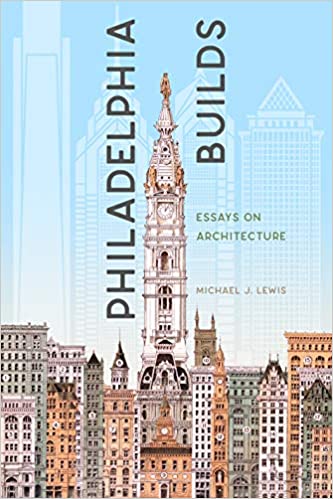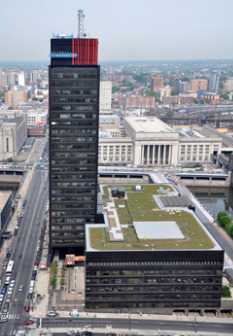Related Topics
Nature Preservation
Nature preservation and nature destruction are different parts of an eternal process.
Architecture in Philadelphia
Originating in a limitless forest, wooden structures became a "Red City" of brick after a few fires. Then a succession of gifted architects shaped the city as Greek Revival, then French. Modern architecture now responds as much to population sociology as artistic genius. Take a look at the current "green building" movement.

City of Homes
At first, there were limitless forests, but then the city burned down. After that, the "Red" city has long been built of brick. Philadelphia's masonry future is unknown, but it won't be wood.
Gardens Flowers and Horticulture
Gardening, flowers and the Flower Show are central to the social fabric of Philadelphia.
Green Roof at Peco

|
| PECO Building |
The Horticulture Society, the Hort to locals, recently conducted a tour of the green roof which Philadelphia Electric, now Exelon has put on the top of that big black building across the street from 30th Street Station. It's a large flat roof, and the ten varieties of sedum are quite handsome.
It's a public service activity, however, designed to help the environmental movement get up some momentum. When you look out at the Philadelphia landscape from the top of a skyscraper, it's possible to see a whole new dimension to the city. On its top, Philadelphia is one huge sea of roofs. If all of those roofs were planted, it would indeed make a huge difference of some sort. Unfortunately, the vast majority of those roofs are residential, slant-roofed, and small.
The Peco roof involved a considerable amount of tailor-made work which would have to be streamlined to make it practical for residences. First, a waterproof liner is put down, then layers of artificial plastic dirt on cushioning layers. Then the plant layer is unrolled, filled with seeds and sprouts of ten different varieties of sedum. Over time, Darwinism takes over, to make the most suitable variety of sedum thrive in the areas most advantageous to it, probably with some judicious watering to get it all started. The result is to reduce the roof temperature in summer from around 160 degrees to 70 degrees, with a consequent reduction in air conditioning costs. It does look rather pretty.
But then some hard facts of economics enter into the discussion. The roof is thought to last fifty years instead of the usual twenty since most deterioration is due to sunlight. Most homeowners don't last fifty years, however, and in fact, the average duration of ownership is around seven years. Most homeowners are skeptical they could pass on the cost to the next owner, and therefore are dubious of promised savings. Churches, museums and public buildings are therefore the most likely market in the early going. The Quakers, as usual, were the first adopters, for their administrative center at fifteenth and Cherry.
And then, there is the height of the building, which is sort of a catch-22. The taller the building, the smaller the proportion of cost savings to the owner; for the most part, the lower stories of a skyscraper are unaffected by what's on the roof. So, office buildings are unlikely to take up the green roof revolution first, or for strictly economic reasons. That leaves mostly residential roofs, which are mostly slanted in this town; the Bauhaus movement hasn't caught on much in this country. It has made more progress in Germany, and Tel Aviv is said to be predominantly Bauhaus. Consequently, we hear tales of these cities getting ahead of us, but it figures. It will be a long time before what Weir Mitchell called The Red City gets rebuilt in a flat-roof style. The proponents feel that green roofs can be adapted to slant-roof structures, but the objections to snow and rain accumulations are obvious obstacles to a city-wide transformation which would even so take a very long time.
There's even a problem with birds, who tend to drop weed seeds where ever they roost. Crabgrass, for example, is an annual which dies each year. Not everybody is willing to devote time every summer to pulling crabgrass off the roof. So, here's another advantage for skyscrapers, which is to say a disadvantage for houses. And some financial wizardry has got to be devised to pass the green roof investment of thousands of houses on to the next, skeptical, owners. And inventors and tinkerers have got to find a thousand little ways to make this process cheaper; at present, it takes too many different tradesmen and artisans to put it all together. In short, it probably costs too much at present to hope to be popular.
Our reaction here is generally favorable to the idea but skeptical of the economics. Except for altruists, idealists, and experimenters. It would seem very fine if more people took it up and perfected it. Meanwhile, it may really not be "ready", as the Quaker says.
Originally published: Wednesday, September 22, 2010; most-recently modified: Tuesday, May 21, 2019